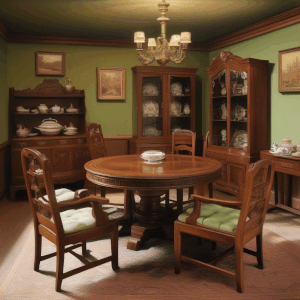Xiaodan Du, Nick Kolkin†, Greg Shakhnarovich, Anand Bhattad
Toyota Technological Institute at Chicago, †Adobe Research
Abstract: Generative models excel at creating images that closely mimic real scenes, suggesting they inherently encode scene representations. We introduce Intrinsic LoRA (I-LoRA), a general approach that uses Low-Rank Adaptation (LoRA) to discover scene intrinsics such as normals, depth, albedo, and shading from a wide array of generative models. I-LoRA is lightweight, adding minimally to the model's parameters and requiring very small datasets for this knowledge discovery. Our approach, applicable to Diffusion models, GANs, and Autoregressive models alike, generates intrinsics using the same output head as the original images. Through control experiments, we establish a correlation between the generative model's quality and the extracted intrinsics' accuracy. Finally, scene intrinsics obtained by our method with just hundreds to thousands of labeled images, perform on par with those from supervised methods trained on millions of labeled examples.
Many thanks to neph1 for the Blender Add-on (vid) and kijai for the ComfyUI integration
Since we use Stable Diffusion, we are releasing under their CreativeML Open RAIL-M license.
2024/6/28: Updated the repo with new title of the paper.
2024/2/13: We now provide inference code: inference_sd_single.py
2024/1/2: We provide checkpoints for our single step SD model. You can download them at GDrive. Load the checkpoint using
pipeline.unet.load_attn_procs(torch.load('path/to/ckpt.bin'))The main packages are listed below
#Conda
pillow=9.2.0
python=3.8.15
pytorch=1.13.0
tokenizers=0.13.0.dev0
torchvision=0.14.0
tqdm=4.64.1
transformers=4.25.1
#pip
accelerate==0.22.0
diffusers==0.20.2
einops==0.6.1
huggingface-hub==0.16.4
numpy==1.22.4
wandb==0.12.21Get Necessary Stable Diffusion Checkpoints from HuggingFace🤗.
We train our single-step UNet model using SDv1.5 and multi-step AugUNet model using SDv2.1. We initialize the additional input channels in AugUNet with IP2P.
We provide code for training the single-step UNet models and the multi-step AugUNet models for surface normal and depth map extraction. Code for albedo and shading should be very similar. Please note that the code is developed for DIODE dataset. To train a model using your own dataset, you need to modify the dataloader. Here we assume that the pseudo labels are stored in the same folder structure as DIODE dataset.
Run the following command to train surface normal single-step UNet model
export MODEL_NAME="runwayml/stable-diffusion-v1-5"
export DATA_DIR="path/to/DIODE/normals"
export PSEUDO_DIR="path/to/pseudo/labels"
export HF_HOME="path/to/HuggingFace/cache/folder"
accelerate launch sd_single_diode_pseudo_normal.py \
--pretrained_model_name_or_path=$MODEL_NAME \
--train_data_dir=$DATA_DIR \
--pseudo_root=$PSEUDO_DIR \
--output_dir="path/to/output/dir" \
--train_batch_size=4 \
--dataloader_num_workers=4 \
--learning_rate=1e-4 \
--report_to="wandb" \
--lr_warmup_steps=0 \
--max_train_steps=20000 \
--validation_steps=2500 \
--checkpointing_steps=2500 \
--rank=8 \
--scene_types='outdoor,indoors' \
--num_train_imgs=4000 \
--unified_prompt='surface normal' \
--resume_from_checkpoint='latest' \
--seed=1234Run the following command to train depth single-step UNet model
export MODEL_NAME="runwayml/stable-diffusion-v1-5"
export DATA_DIR="path/to/DIODE/depths"
export PSEUDO_DIR="path/to/pseudo/labels"
export HF_HOME="path/to/HuggingFace/cache/folder"
accelerate launch sd_single_diode_pseudo_depth.py \
--pretrained_model_name_or_path=$MODEL_NAME \
--train_data_dir=$DATA_DIR \
--pseudo_root=$PSEUDO_DIR \
--output_dir="path/to/output/dir" \
--train_batch_size=4 \
--dataloader_num_workers=4 \
--learning_rate=1e-4 \
--report_to="wandb" \
--lr_warmup_steps=0 \
--max_train_steps=20000 \
--validation_steps=2500 \
--checkpointing_steps=2500 \
--rank=8 \
--scene_types='outdoor,indoors' \
--num_train_imgs=4000 \
--unified_prompt='depth map' \
--resume_from_checkpoint='latest' \
--seed=1234Run the following code to train surface normal multi-step AugUNet model
export MODEL_NAME="stabilityai/stable-diffusion-2-1"
export DATA_DIR="path/to/DIODE/normals"
export PSEUDO_DIR="path/to/pseudo/labels"
export HF_HOME="path/to/HuggingFace/cache/folder"
accelerate launch augunet_diode_pseudo_normal.py \
--pretrained_model_name_or_path=$MODEL_NAME \
--train_data_dir=$DATA_DIR \
--pseudo_root=$PSEUDO_DIR \
--output_dir="path/to/output/dir" \
--train_batch_size=4 \
--dataloader_num_workers=4 \
--learning_rate=1e-4 \
--report_to="wandb" \
--lr_warmup_steps=0 \
--max_train_steps=50000 \
--validation_steps=2500 \
--checkpointing_steps=2500 \
--rank=8 \
--scene_types='outdoor,indoors' \
--unified_prompt='surface normal' \
--resume_from_checkpoint='latest' \
--seed=1234Run the following code to train depth multi-step AugUNet model
export MODEL_NAME="stabilityai/stable-diffusion-2-1"
export DATA_DIR="path/to/DIODE/depths"
export PSEUDO_DIR="path/to/pseudo/labels"
export HF_HOME="path/to/HuggingFace/cache/folder"
accelerate launch augunet_diode_pseudo_depth.py \
--pretrained_model_name_or_path=$MODEL_NAME \
--train_data_dir=$DATA_DIR \
--pseudo_root=$PSEUDO_DIR \
--output_dir="path/to/output/dir" \
--train_batch_size=4 \
--dataloader_num_workers=4 \
--learning_rate=1e-4 \
--report_to="wandb" \
--lr_warmup_steps=0 \
--max_train_steps=50000 \
--validation_steps=2500 \
--checkpointing_steps=2500 \
--rank=8 \
--scene_types='outdoor,indoors' \
--unified_prompt='depth map' \
--resume_from_checkpoint='latest' \
--seed=1234Our code should be compatible with "fp16" precision by just appending --mixed_precision="fp16" to accelerate launch. However we train all of our models using the full precision. Please let us know if you encounter problems using "fp16".
@article{du2023intrinsic,
title={Intrinsic LoRA: A Generalist Approach for Discovering Knowledge in Generative Models},
author={Du, Xiaodan and Kolkin, Nicholas and Shakhnarovich, Greg and Bhattad, Anand},
journal={arXiv preprint arXiv:2311.17137},
year={2023}
}


